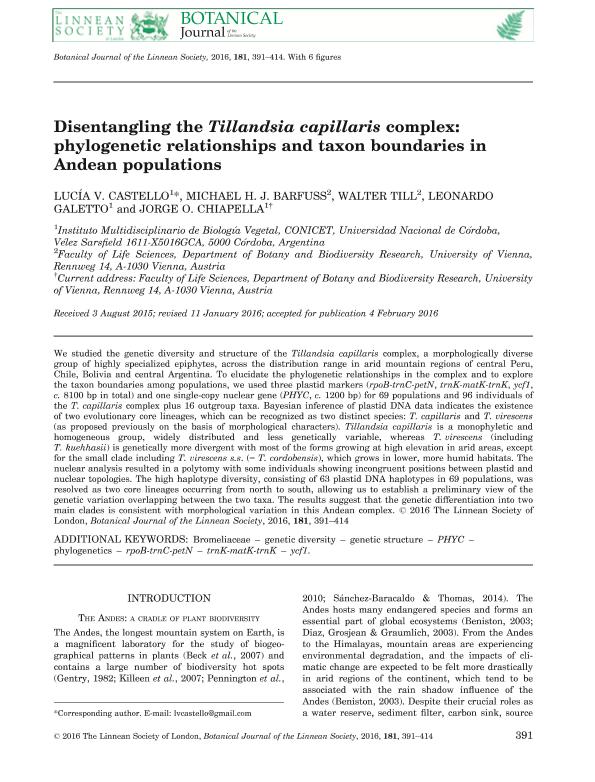Mostrar el registro sencillo del ítem
dc.contributor.author
Castello, Lucía Virginia

dc.contributor.author
Barfuss, Michael H.
dc.contributor.author
Till, Walter
dc.contributor.author
Galetto, Leonardo

dc.contributor.author
Chiapella, Jorge Oscar

dc.date.available
2017-06-08T15:35:22Z
dc.date.issued
2016-07
dc.identifier.citation
Castello, Lucía Virginia; Barfuss, Michael H.; Till, Walter; Galetto, Leonardo; Chiapella, Jorge Oscar; Disentangling the Tillandsia capillaris complex: phylogenetic relationships and taxon boundaries in Andean populations; Wiley Blackwell Publishing, Inc; Botanical Journal Of The Linnean Society; 181; 3; 7-2016; 391-414
dc.identifier.issn
0024-4074
dc.identifier.uri
http://hdl.handle.net/11336/17769
dc.description.abstract
We studied the genetic diversity and structure of the Tillandsia capillaris complex, a morphologically diverse group of highly specialized epiphytes, across the distribution range in arid mountain regions of central Peru,Chile, Bolivia and central Argentina. To elucidate the phylogenetic relationships in the complex and to explore the taxon boundaries among populations, we used three plastid markers (rpoB-trnC-petN, trnK-matK-trnK, ycf1,c. 8100 bp in total) and one single-copy nuclear gene (PHYC, c. 1200 bp) for 69 populations and 96 individuals ofthe T. capillaris complex plus 16 outgroup taxa. Bayesian inference of plastid DNA data indicates the existence of two evolutionary core lineages, which can be recognized as two distinct species: T. capillaris and T. virescens(as proposed previously on the basis of morphological characters). Tillandsia capillaris is a monophyletic and homogeneous group, widely distributed and less genetically variable, whereas T. virescens (including T. kuehhasii) is genetically more divergent with most of the forms growing at high elevation in arid areas, except for the small clade including T. virescens s.s.(= T. cordobensis), which grows in lower, more humid habitats. The nuclear analysis resulted in a polytomy with some individuals showing incongruent positions between plastid and nuclear topologies. The high haplotype diversity, consisting of 63 plastid DNA haplotypes in 69 populations, was resolved as two core lineages occurring from north to south, allowing us to establish a preliminary view of the genetic variation overlapping between the two taxa. The results suggest that the genetic differentiation into two main clades is consistent with morphological variation in this Andean complex.
dc.format
application/pdf
dc.language.iso
eng
dc.publisher
Wiley Blackwell Publishing, Inc

dc.rights
info:eu-repo/semantics/openAccess
dc.rights.uri
https://creativecommons.org/licenses/by-nc-sa/2.5/ar/
dc.subject
Bromelliaceae
dc.subject
Genetic Diversity
dc.subject
Genetic Structure
dc.subject
Phyc
dc.subject
Phylogenetics
dc.subject
Rpob-Trnc-Petn
dc.subject
Trnk-Matk-Trnk
dc.subject
Ycf1
dc.subject.classification
Ciencias de las Plantas, Botánica

dc.subject.classification
Ciencias Biológicas

dc.subject.classification
CIENCIAS NATURALES Y EXACTAS

dc.title
Disentangling the Tillandsia capillaris complex: phylogenetic relationships and taxon boundaries in Andean populations
dc.type
info:eu-repo/semantics/article
dc.type
info:ar-repo/semantics/artículo
dc.type
info:eu-repo/semantics/publishedVersion
dc.date.updated
2017-06-06T14:42:38Z
dc.journal.volume
181
dc.journal.number
3
dc.journal.pagination
391-414
dc.journal.pais
Reino Unido

dc.journal.ciudad
Londres
dc.description.fil
Fil: Castello, Lucía Virginia. Consejo Nacional de Investigaciones Científicas y Técnicas. Centro Científico Tecnológico Conicet - Córdoba. Instituto Multidisciplinario de Biología Vegetal. Universidad Nacional de Córdoba. Facultad de Ciencias Exactas Físicas y Naturales. Instituto Multidisciplinario de Biología Vegetal; Argentina
dc.description.fil
Fil: Barfuss, Michael H.. Universidad de Viena. Instituto de Botanica; Austria
dc.description.fil
Fil: Till, Walter. Universidad de Viena. Instituto de Botanica; Austria
dc.description.fil
Fil: Galetto, Leonardo. Consejo Nacional de Investigaciones Científicas y Técnicas. Centro Científico Tecnológico Conicet - Córdoba. Instituto Multidisciplinario de Biología Vegetal. Universidad Nacional de Córdoba. Facultad de Ciencias Exactas Físicas y Naturales. Instituto Multidisciplinario de Biología Vegetal; Argentina
dc.description.fil
Fil: Chiapella, Jorge Oscar. Consejo Nacional de Investigaciones Científicas y Técnicas. Centro Científico Tecnológico Conicet - Córdoba. Instituto Multidisciplinario de Biología Vegetal. Universidad Nacional de Córdoba. Facultad de Ciencias Exactas Físicas y Naturales. Instituto Multidisciplinario de Biología Vegetal; Argentina
dc.journal.title
Botanical Journal Of The Linnean Society

dc.relation.alternativeid
info:eu-repo/semantics/altIdentifier/url/http://onlinelibrary.wiley.com/doi/10.1111/boj.12400/abstract
dc.relation.alternativeid
info:eu-repo/semantics/altIdentifier/doi/http://dx.doi.org/10.1111/boj.12400
dc.relation.alternativeid
info:eu-repo/semantics/altIdentifier/url/https://academic.oup.com/botlinnean/article-abstract/181/3/391/2707803/Disentangling-the-Tillandsia-capillaris-complex?redirectedFrom=fulltext
Archivos asociados
